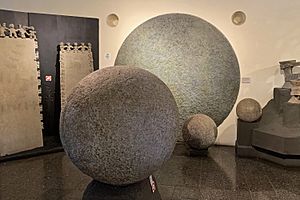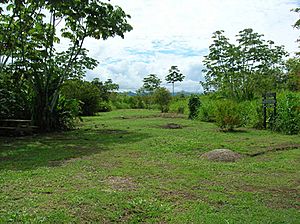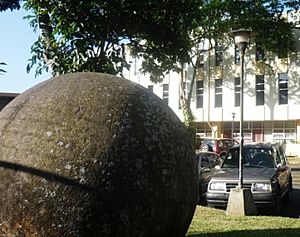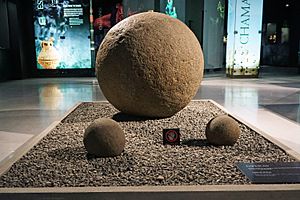Stone spheres of Costa Rica facts for kids
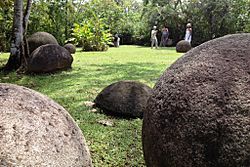
Stone spheres of the Diquís at the Finca 6 archaeological site
|
|
| Location | Palmar Sur, Osa, Puntarenas, Costa Rica |
|---|---|
| Region | Osa, Puntarenas |
| Coordinates | 8°54′41″N 83°28′39″W / 8.91139°N 83.47750°W |
| History | |
| Periods | 500–1500 CE |
| Cultures | Diquís culture |
| Official name | Precolumbian chiefdom settlements with stone spheres of the Diquís |
| Type | Cultural |
| Criteria | iii |
| Designated | 2014 (38th session) |
| Reference no. | 1453 |
| State Party | Costa Rica |
| Region | Latin America and the Caribbean |
The stone spheres of Costa Rica are a collection of over 300 large, round stones found in Costa Rica. They are mostly located in the Diquís Delta and on Isla del Caño. People in Costa Rica often call them bolas de piedra, which means "stone balls."
These mysterious spheres are believed to have been made by the ancient Diquís culture. This culture lived in the area a very long time ago and is now extinct. Because of this, the spheres are sometimes called the Diquís Spheres. They are the most famous stone sculptures from the Isthmo-Colombian Area, a region that includes parts of Central and South America.
Archaeologists think the spheres might have been placed in lines leading to the homes of important leaders. However, their exact meaning is still a mystery. Some experts guess they could represent the solar system. Others think they might show different stages of the sun and moon. In June 2014, these ancient sites with stone spheres became a World Heritage Site by UNESCO. This means they are very important to the world's history and culture.
Contents
What Are These Stone Spheres?
The stone spheres come in many different sizes. Some are just a few centimeters wide, while others are huge. The largest ones are over 2 meters (6.6 feet) across and can weigh up to 15 tons. That's as heavy as a large truck!
Most of the spheres are carved from a hard rock called gabbro. This rock is similar to basalt. A few spheres are made from limestone or sandstone. Scientists believe the ancient people made them by hammering natural boulders with other rocks. Then, they polished them smooth using sand. The quality of the carving varies, with some spheres being very precise and others less so. The gabbro rock came from hills several kilometers away. Some unfinished spheres can still be found in those hills.
Where Are They Found?
The main place where these stone spheres are found is the Diquís Delta. This area is in the southern part of Costa Rica, in the Puntarenas Province. The Diquís Delta is a flat plain surrounded by hills and the Pacific Ocean.
One important archaeological site is called "Finca 6" (Farm 6). This site is in Palmar Sur, a town in southern Costa Rica. Finca 6 covers about 10 hectares (25 acres) of land. This land used to belong to the United Fruit Company.
Finca 6 was an important place for the ancient Diquís people. It was a settlement where they lived and also a burial ground. There are also remains of large buildings and sculptures there. Two mounds built with river stones and earth have been found. Many stone spheres are still in their original spots at Finca 6. Some spheres that were moved from other places have been brought back to Finca 6 for safekeeping by the National Museum.
Who Made Them and When?
The stone spheres are believed to have been first made around the year 600 CE. Most of them were created between 1000 CE and the arrival of the Spanish. The people who made these stones were part of the Diquís culture. This culture disappeared after the Spanish arrived in the Americas.
It's hard to know the exact age of each stone. This is because many of them are no longer in their original locations. Archaeologists use a method called stratigraphy to date objects. This involves studying the layers of earth where things are found.
What Happened After They Were Found?
The stone spheres were rediscovered in the 1930s. This happened when the United Fruit Company was clearing the jungle to create banana plantations. Workers used bulldozers and heavy machines, which unfortunately damaged some of the spheres.
Some workers also believed there was gold hidden inside the spheres. They drilled holes into them and blew them open with dynamite. Many spheres were destroyed this way before authorities stepped in to stop it. Today, some of these broken spheres have been put back together. You can see them on display at the National Museum of Costa Rica in San José. The museum has six of these amazing spheres. Many other spheres ended up as lawn decorations in people's yards across Costa Rica.
The first scientific study of the spheres was done by Doris Stone in 1943. Later, in 1948, Samuel Kirkland Lothrop from Harvard University also studied them. His findings were published in 1963. In 2010, a researcher named John Hoopes visited the site. He helped evaluate the spheres for their protection as a UNESCO World Heritage Site.
Why Are They Important?
The stone spheres are a very important national symbol of Costa Rica. They represent the country's rich history and culture. You can often see them in government buildings. For example, seven spheres from the National Museum were placed inside the new building of the Legislative Assembly of Costa Rica in 2019.
These spheres have also inspired many artists and architects. Sculptors like Ibo Bonilla and Jorge Jiménez Deredia have created art based on them. Their unique shapes and mystery continue to fascinate people.
Gallery: Diquís stone spheres in art
-
Arrullo from the open air exposition “Jiménez Deredia en San José: La Fuerza y la Universidalidad de la Esfera”, San José, Costa Rica
-
Steel sculpture by Ibo Bonilla, with 18 m (59 ft) is the tallest in Costa Rica
-
Architectonic-sculptural arrangement at Plaza de la Justicia, San José, by Ibo Bonilla.
Myths and Mysteries
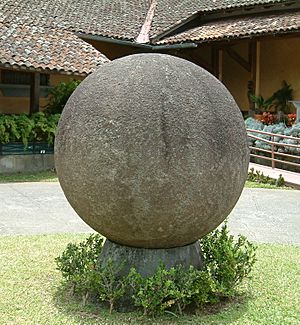
Many myths and legends surround the stone spheres. Some people used to believe they came from the lost city of Atlantis. Others thought they were formed naturally by nature. One local legend says that the ancient people had a special potion that could soften rock. While limestone can be dissolved by plant acids, most spheres are made of gabbro, which is a very hard, acid-resistant rock.
In the stories of the Bribri people, the stone spheres are called "Tara’s cannon balls." Tara, or Tlatchque, was the god of thunder. He supposedly used a giant blowpipe to shoot these balls at the Serkes, who were gods of winds and hurricanes. He did this to drive them away from the land.
Some people have claimed that the spheres are perfectly round. However, studies show that some spheres can vary by more than 5 centimeters (2 inches) in diameter. Also, the stones have been damaged and worn down over many years. This makes it impossible to know their exact original shape. Early measurements that suggested perfect roundness were likely due to how the measurements were taken.
Tourism
Visiting archaeological sites is still quite new in Costa Rica. The site of Finca 6 is now open to visitors. You can pay a small fee to see the museum display and then walk around the grounds. This allows you to see some of the places where the spheres were found. The National Museum of Costa Rica plans to open the site to more tourism in the future. They also hope to include other nearby sites in the region.
See also
 In Spanish: Esferas de piedra de Costa Rica para niños
In Spanish: Esferas de piedra de Costa Rica para niños



